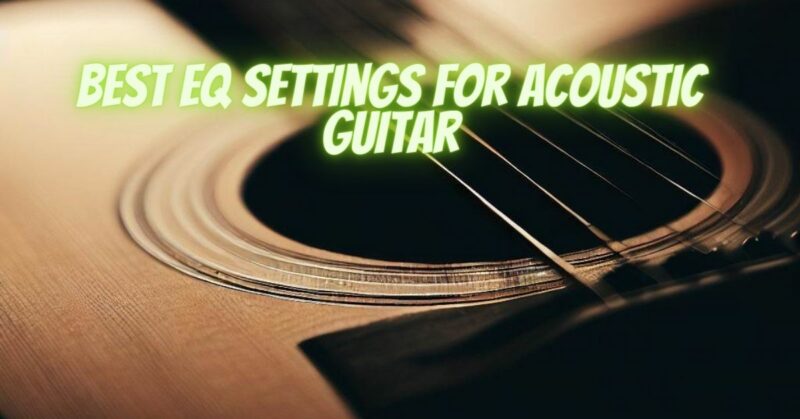The acoustic guitar is a versatile and resonant instrument that can be further enhanced through careful equalization. Equalizer settings play a crucial role in shaping the tonal character of an acoustic guitar, allowing you to emphasize its natural warmth, clarity, and presence. This article provides guidance on recommended equalizer settings for acoustic guitar, helping you achieve a balanced and captivating sound.
Understanding Equalization:
Equalization, or EQ, involves adjusting the balance of frequencies within an audio signal. It allows you to boost or cut specific frequency ranges to shape the overall sound of an instrument or mix.
Recommended Equalizer Settings for Acoustic Guitar:
While the ideal equalizer settings can vary depending on the acoustic guitar, the room, and the style of music, here’s a general guideline to get you started:
- Low Frequencies (Bass):
- Boost: Around 80 Hz to add warmth and body to the sound.
- Cut: Below 50 Hz to eliminate rumble and excessive low-end.
- Low-Mid Frequencies:
- Boost: Around 200-400 Hz to enhance the guitar’s midrange presence and projection.
- Cut: Address any muddiness by slightly cutting around 200-300 Hz.
- Mid Frequencies:
- Boost/Cut: Tweak around 800 Hz to shape the guitar’s tonal character. Boosting can add warmth, while cutting can reduce honky or boxy qualities.
- High-Mid Frequencies:
- Boost: Around 2-3 kHz to enhance articulation and clarity.
- Cut: Around 1-2 kHz to reduce any harshness or brittleness.
- High Frequencies (Treble):
- Boost: Around 5-6 kHz for brilliance and shimmer in the upper frequencies.
- Cut: Above 10 kHz to tame excessive brightness and sibilance.
Additional Tips:
- Experimentation:
- Every acoustic guitar is unique, so feel free to experiment with these guidelines to find the best settings for your specific instrument.
- Room Acoustics:
- Consider the acoustics of your recording or performance space. Adjustments might be needed based on the room’s characteristics.
- Playing Style and Genre:
- Your playing style and the genre of music you’re performing can influence your EQ choices. Fingerstyle, strumming, and picking can benefit from different EQ emphasis.
- Listening Environment:
- Listen to your guitar through quality studio monitors, headphones, or live sound systems to accurately assess the EQ adjustments.
Equalization is a powerful tool that allows you to sculpt the sonic palette of your acoustic guitar to perfection. By following these recommended equalizer settings and adapting them to suit your unique instrument and musical context, you can unlock the full expressive potential of your acoustic guitar, creating a captivating and harmonious sonic experience that resonates with audiences and listeners alike.


